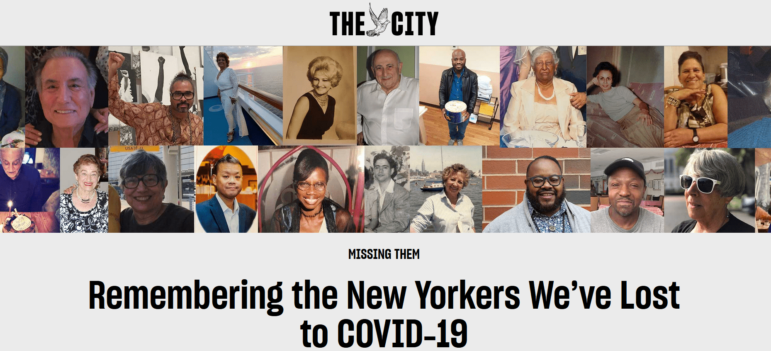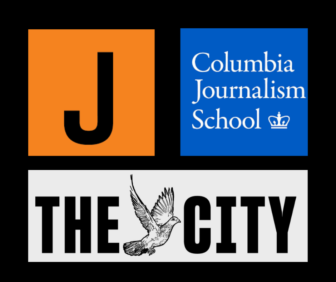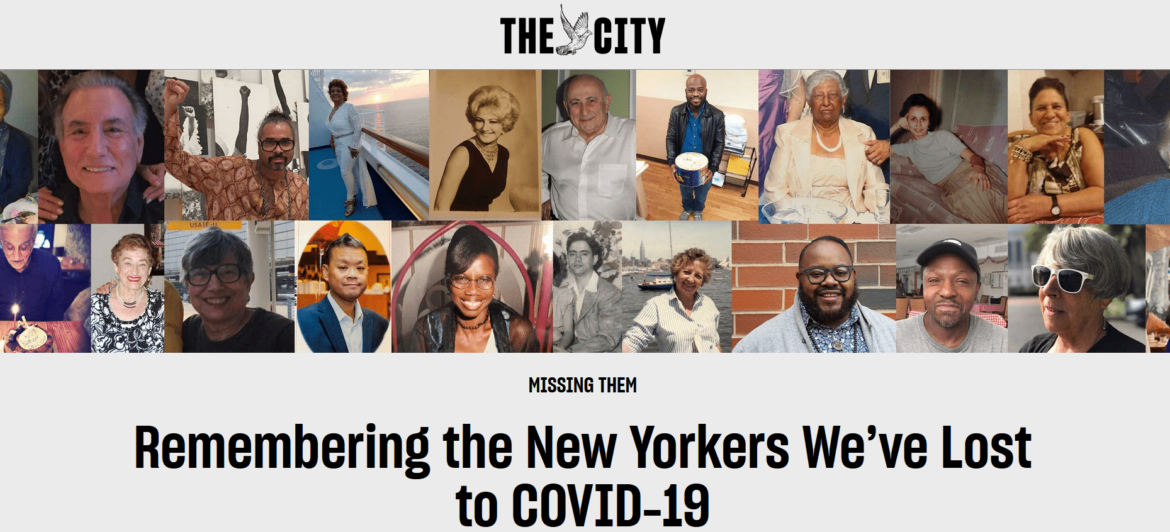

Collaborating to Identify COVID-19’s Victims in New York City
By the time journalists from The City and the Columbia Journalism School started discussing an idea to memorialize every New Yorker that died due to the coronavirus, about 3,000 lives had already been lost.
That was early April. It was a number — even at an early stage — that made the project seem too ambitious for a single newsroom to execute.
As the numbers grew daily, it became clear that remembering every New Yorker who died due to the coronavirus would need to embrace collaboration at all levels.
That idea is now called Missing Them — an ambitious collaborative journalism project teaming the Columbia Journalism School’s Toni Stabile Center for Investigative Journalism, Columbia Journalism Investigations, the Newmark Graduate School of Journalism at CUNY, and the nonprofit newsroom The City.
As of July 1, COVID-19 has killed more than 22,000 New Yorkers. Few names — and even fewer faces and stories — have been shared publicly.
Fewer than 5% have been remembered with a paid or staff-written news outlet obituary or other death notice. The publicized deaths skew male and younger. They also disproportionately come from wealthier enclaves of the city than the general population killed by the virus.
The result: The deaths of some groups hardest hit by coronavirus — including Black and Latino residents and recent immigrants living in poorer and more crowded conditions in Bronx and Queens neighborhoods — often go unnoticed by anyone other than their families, coworkers, and friends. Missing Them seeks to change that.
The Public Record
The project brings together fellows from the Newmark and Columbia journalism schools, as well as any New Yorker who wants to share a story through a form, phone call, or text message about a person who died. More than a dozen graduate students and recent graduates have worked to confirm the deaths of 1,074 New Yorkers, and mark their lives using pictures and words.
So how are we all working together? A big part of our work has involved gathering stories of those who have died. We’re scouring obituaries on Legacy.com, as well as publications like The New York Times, the New York Daily News, and Staten Island Advance.
We’re reaching out to organizations across the city that are commemorating, both publicly and privately, members who have died from COVID-19. The Bronx Borough President’s Office, for example, maintains a public page of Bronxites who died of the coronavirus. We’ve also identified hundreds of names and stories through unions representing teachers, nurses, transportation workers, and other civil servants.
In addition, we’ve gathered lists from dozens of city agencies, social media pages and other memorial projects, including @FacesOfCOVID and #NamingTheLost.
Participation
A key part of Missing Them is community engagement. On May 8, we launched a short form asking people who have lost a relative, friend, coworker or neighbor to the coronavirus to share their story with us. We also have a hotline for folks to call in, and a questionnaire delivered via text when folks text “remember” to 73224.
So far, nearly 300 people have filled out our form, emailed, called, or texted us. Our team of journalism students and fellows is contacting each person who writes in to set up an interview, gather photographs and funeral programs, and craft a short obituary to honor each person.
The Stories We’ve Told
Lemuel Sison, who worked as a medical technician in Long Island, was one of the first to die from COVID-19. Luca Powell, a Newmark student and fellow at The City, interviewed his daughter, Leighvanni, who said Sison was a pillar of the Filipino-American community in Queens and helped people “without demanding anything in return.” Sison was just one of the many Filipinos in the frontline medical community to fall victim to the virus while keeping New Yorkers alive.
Gaetana Deserto died of COVID-19 on April 6 at the age of 63. Rosa Schwartzburg, a recent Columbia graduate and fellow from the Institute for Nonprofit News (INN), interviewed Deserto’s son, Rocco, to learn more about her life. She was born in Sicily and moved to New York City as a teenager, where she built a career in healthcare administration, working as an insurance claims agent then as a desk attendant in a gastroenterology office. In recent years, when her husband’s health declined, Deserto served as a full-time caregiver — always keeping a “hospital purse” ready with a change of clothes, a hairbrush, and toothbrush in case he had to be rushed to the emergency room. “My mother would walk miles with two broken legs for anyone in her family,” Rocco Deserto said.
Caitlin Antonios, another fellow from INN and graduate of Columbia’s Stabile program, wrote about Clinton Washington, a client advocate for the Bronx Freedom Fund. Washington worked tirelessly to help his clients post bail, keep track of court dates, secure transportation and income while they awaited trial. Washington, who died on May 6 at a Bronx hospital at age 40, was generous and had a passion for social justice, according to his colleagues.
Fellow Caroline Leddy, a graduate student at the Newmark school, interviewed Patricia Rojas about her mother, Ana Ortiz. Ortiz, who immigrated to the United States from the Dominican Republic in the late 1960s, worked as a home health aide for people with developmental disabilities. Ortiz, who had seven siblings, worked tirelessly to send money home and provide a Catholic education for her daughter. Ortiz and Rojas loved spending time together. “She never failed to tell me and she never failed to show me that she loved me,” Rojas said.
Fellow Frank DiFiore, who is also a graduate student at Newmark, interviewed Wayne Wong to learn more about his older brother, Fook Sheong Wong. The longtime Queens resident immigrated to the United States in the 1960s when he was 18, reuniting with his parents. He worked in laundromats and restaurants — some of the few businesses that welcomed Chinese-American workers without hesitation. Wong was a loving father to his children, Alex and Serena. He was also an avid mahjong player, according to his brother. “He played it whenever he had free time,” Wayne Wong said.
We’ve called or emailed more than a hundred other families so far. That could reach thousands and perhaps tens of thousands before we’re through.
Leveraging Networks
We’re leveraging as many platforms and networks as we can to reach New Yorkers.
We use platforms like Facebook as avenues of outreach to let folks know about the project and start conversations in all pockets of every borough. We’ve compiled a list of more than 200 (and counting) New York City Facebook groups. We’re posting in these groups regularly about the project and our stories. We also ask community members to share the project with people in their own circles. We circle back every few weeks to check in and share updates about the project with those who have shown interest.
One successful example of how this works: After we posted in one of the groups, a Bangladeshi American doctor who lives in New York contacted us about his effort to document all those in the Bangladeshi community who have died. At the time, his spreadsheet had about 170 names. It has grown since. We jumped on a call, talked through the list, and are now incorporating it into the larger memorial.
Another way we aim to reach more folks is translating the project into different languages. Our form is currently only available in English. But we know that to reach some of the hardest hit communities and reach all New Yorkers, the project needs to be accessible in other languages. So with the help of the Queens Public Library, we are translating our form and text bot into multiple languages — Spanish, Chinese, and Yiddish to start.
Many other groups have reached out wanting to help and share. Everything from the Lincoln Center’s Memorial For All Of Us project to various advocacy groups for the homeless to community institutions like libraries and museums have expressed interest in working with us.
Missing Them is not a project of a single organization or a single community. It is not a project from “The City” but a project of “the city.”
An Evolving Digital Memorial
All of the above is flowing into our digital memorial page. This is the first iteration of what this page will look like. We update it a few times a week. We show all the names we’ve verified from the various lists, along with short bios, and dozens of images that were shared with us directly from the families.
You can search the database by last name or sort by name, age, borough, and date of death.
The page also operates as a call-out, asking folks to share names they don’t find there.
We only include names in the memorial after researchers have confirmed a death with a third party, such as a news organization or city agency, and directly tied the cause to COVID-19. The verification process checks some victim details, such as last known address and age, using New York City voter registration data and other sources. Other details, such as the date of a victim’s death and underlying health conditions, are typically provided by the family and have not been independently confirmed.
How We’re Writing Stories
The goal of the project is to make sure folks see the people behind the numbers. And when you’re dealing with people, you’re dealing with stories. We’ve published a few along the way so far.
Over Memorial Day weekend, we published a story about the toll of the coronavirus at the New York State Veterans Home in St. Albans, Queens — one of five state-run nursing homes in New York. The City reporter Yoav Gonen obtained a leaked list of 48 veterans or spouses who died at the facility between March and April 2020. Over the course of three days, a team of five reporters and fellows reached out to the next-of-kin for each person who died. We were able to verify 25 people from that list. The resulting article captured both the stories of those who were lost and raised key questions about whether the facility properly accounted for the full scope of fatalities.
We also looked into the cost of dying — including how expensive obituaries are. The cost of publishing a paid obituary in local and national newspapers ranges from $250 to $600. Schneps Media, which owns several community newspapers that include the Bronx Times and The Queens Courier, charges $250 for obituaries with photos and, at a minimum, $20 for 20 words of text. New York Amsterdam News’s advertising department quoted $399 for an 300-word-long obituary with a passport-size photo of the deceased.
The New York Times charges at least $236.34 for a one-day publication in its national edition and online. The New York Daily News said its average obituary rate is nearly $600. Most outlets don’t offer free options.
To talk about stories, the three editors on the project — Anjali Tsui, Derek Kravitz, and Terry Parris Jr. — hold office hours with the fellows to go through story pitches or just brainstorm ideas. We have stories in the works looking at veterans, how women are underrepresented in obituaries, how immigrant communities are coping with the inability to send remains back to their home countries, and much more.
We won’t be able to tell every one of these stories, so we are actively looking for and talking to local media partners to collaborate. If that’s you, email us at memorial@thecity.nyc.
Volunteers Step Up to Help
As the coronavirus spread throughout New York and our hospitals were seemingly on the verge of collapse, we heard story after story of health care professionals volunteering their time to help fight the disease and protect New York.
As journalists, we can’t equate the impact of what we do to that of health care workers. But we know that there are a lot of us journalists who want to help in some way.
While our skills don’t translate to the front lines of fighting a global pandemic, they do translate to the front lines of history. From the moment we launched this project, we started getting emails from journalists, writers, researchers, teachers, all who want to help us find families and write stories about their loved and lost. We mentioned this during an interview with On The Media.
Since then, 100 folks have reached out to us, volunteering their services and their time to help us track down families and write these stories. We get note after note from journalists — retired and otherwise — telling us that they’re looking for a way to help during the pandemic. They see Missing Them as that opportunity.
We haven’t moved into that phase of the project just yet. But over the next month, we’ll be reaching out to folks to vet them, organize them, and get them started on the project.
This Is Heavy Work
At our meetings, we often say that this isn’t a project about death, but a project about life. We aren’t putting a spotlight on the growing number of dead but celebrating individual lives. Still, we are dealing with some grim material, grieving families, and a crisis with no real end in sight. This is tough, emotional work, no matter how you frame it.
We are having regular and open conversations about self-care and what our mindset is around the project. Bruce Shapiro, executive director of the Dart Center for Journalism and Trauma, recently gave us a training session. Here are a few points we took away:
- It’s important to carve out “recovery time” when working on a project like this one. We need time away from our devices and from constant stimulation — even if it’s just for a few minutes.
- Keeping a work journal — a list of everything you did and everything you want to do — is one way to stay grounded and motivated.
- Social isolation can make it harder to process trauma. Having colleagues you can lean on helps.
Shapiro also discussed the importance of reflecting on our work after each milestone. He suggested we ask ourselves these questions:
- What did we do right?
- What were we challenged by?
- What is the lesson learned?
We are incorporating these questions into our workflow. It’s not perfect, but we’re trying.
Can You Help Out?
This wouldn’t be a post about collaboration and engagement without asking you a few questions:
- For those who are engaged in this heavy work of memorializing COVID-19 victims or working on the crisis in general, how are you taking care of yourself or your team? We’d love to hear it.
- If you are working on a memorial project or have come across one you like, please share it with us.
- Finally, if you know someone in New York City who has died as a result of COVID-19, please let us know. Here’s how you can share a story:
-
- Call our hotline: (646) 494–1095
- Text “remember” to 73224
- Email us at: memorial@thecity.nyc
More Reading on Collaborations
How Latin American Media Outlets are Collaborating on COVID-19 Investigations
10 Tips for Successful Collaboration Among Journalists
A Model Collaboration That’s Working to Rebuild Local News in Colorado
Considering a Collaborative Reporting Project? Here are 8 Lessons From 6 Projects
 This story, a collaboration by the Newmark Graduate School of Journalism at CUNY, Columbia Journalism School and The City, was originally published on the Newmark Graduate School of Journalism’s Social Journalism Medium page. Here is the original post, which is republished on our site with permission.
This story, a collaboration by the Newmark Graduate School of Journalism at CUNY, Columbia Journalism School and The City, was originally published on the Newmark Graduate School of Journalism’s Social Journalism Medium page. Here is the original post, which is republished on our site with permission.













